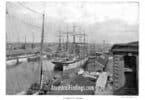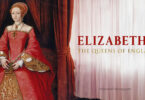King George III of England (the same one who was King during the American Revolution) had an heir problem. The problem was none of his fifteen children had produced a legitimate heir, save for his eldest son, the future King George IV, who had a legitimate daughter named Charlotte. Some of his nine sons had illegitimate children, three of his six daughters married but had no surviving children, and three of his daughters never married at all. The entire future of the kingdom was placed on Princess Charlotte.
Princess Charlotte was the heir presumptive for most of her life and was beloved by the English people. When she crossed to the other side in childbirth at only twenty-one years old (and the baby with her), it was a calamity for the British monarchy. The race to produce a legitimate grandchild of the King to be the heir for the next generation was on among the king’s sons, all of whom were over forty years old at the time.
It was Prince Edward, the king’s fifth son, who heeded the call, dismissing the mistress with whom he had been living in Brussels and proposing marriage to the sister of Princess Charlotte’s widower. In 1819, two years after the country lost Charlotte, Edward’s wife gave birth to their legitimate daughter, Alexandrina Victoria. This daughter, the only child the couple had together, would grow up to become Queen Victoria of the United Kingdom of Great Britain.
Victoria’s father, having produced a legitimate heir to the kingdom, crossed to the other side when Victoria was less than a year old. Her grandfather, King George III, crossed only a week after Victoria’s father. This left Charlotte’s father as King George IV. George, who was estranged from his wife, had no more children and crossed in 1830. This left George’s brother William as King William IV. William had illegitimate children, but his two legitimate daughters were both born around the same time as Victoria, but they both crossed as infants. This left Victoria as heir presumptive.

Since William IV didn’t trust Victoria’s mother to be able to competently conduct a regency, William declared that he intended to live until Victoria was at least eighteen years old, which would make a regency unnecessary. To the delight of almost everyone, he accomplished just that.
Victoria described her childhood as lonely and melancholy. Her mother was extremely protective of her and brought her up under a strict set of rules she called the “Kensington system.” Victoria was only allowed to be around people her mother and her comptroller/supposed lover Sir John Conroy deemed acceptable (which excluded most of her father’s royal side of the family), was made to sleep in the same bedroom as her mother every night, followed a rigorous tutoring schedule, and her playtime was limited to dolls and her pet dog, Dash. She was also mostly kept away from court, as her mother was supposedly scandalized by the presence there of King William IV’s illegitimate children.
Victoria’s mother and John Conroy intended to raise Victoria to be weak-willed and dependent on them. It had the opposite effect. Despite pressure from both of them to appoint Conroy to her household, the teenage Victoria refused. Once she became Queen, she banished Conroy from her sight (though he remained in her mother’s household), and only rarely deigned to visit with her mother. She had a lot of resentment for the way the two of them raised her.
A marriage match was proposed for her when she was seventeen years old. Her mother’s brother Leopold (the now re-married widower of Princess Charlotte), who was then King of Belgium, wanted to marry his niece to his brother’s son, Albert. King William IV, though, wanted to marry her to the second son of the Prince of Orange. Victoria entertained several suitors, but it was clear she liked Albert the best. Her diary describes their first meeting, when he came to England to see her, in glowing terms. She did not think she was ready for marriage yet, but her desire for Albert was such that most involved in the marriage negotiations thought their union at some time in the future was all but a mere formality. From the moment they met, Victoria only had eyes for Albert.
A month after Victoria turned eighteen years old, her uncle William, King William IV of England, crossed to the other side at age seventy-one. Victoria was awakened and informed she was Queen at six o’clock in the morning, after which she went back to bed, alone this time. She was Queen now, and her mother and Conroy were her subjects. If she didn’t want to sleep in the same room as her mother anymore, she did not have to.
She signed a few documents on her first day as Queen with her full name, Alexandrina Victoria (always called Drina by her mother), then crossed the first name out and asked that it not be used anymore. She was Queen Victoria, and that is how she would from then on be known.
Britain and the kingdom of Hanover had shared a monarch since George I ascended the English throne in 1714. Hanoverian law, though, did not allow women to ascend to the throne, so Victoria’s uncle, her father’s younger brother Ernest, ascended to the Hanoverian throne, ending the personal union between Great Britain and Hanover. Until Victoria had children, her uncle Ernest was her heir presumptive.
Even though Victoria wanted complete independence from her mother, social convention at the time dictated that an unmarried woman had to live with a parent or guardian, even if she was Queen. So, Victoria consigned her to a distant apartment in Buckingham Palace and often refused to see her. Her advisers told her she could remedy the situation by marrying, but she did not want to be hurried into it.
Albert came to visit a second time in 1839, and Victoria found him just as captivating as she had three years prior to their first meeting. She proposed to him (as was required, since she was a Queen, and he was only a prince of another kingdom) just five days after he arrived in Great Britain. They were married in 1840.
The day after her wedding, Victoria wrote in her diary:
“I NEVER, NEVER spent such an evening!!! MY DEAREST DEAREST DEAR Albert … his excessive love & affection gave me feelings of heavenly love & happiness I never could have hoped to have felt before! He clasped me in his arms, & we kissed each other again & again! His beauty, his sweetness & gentleness – really how can I ever be thankful enough to have such a Husband! … to be called by names of tenderness, I have never yet heard used to me before – was bliss beyond belief! Oh! This was the happiest day of my life!”
Victoria gave birth to their first child, a daughter also named Victoria; later the same year, they were married. She hated being pregnant, thought breastfeeding was disgusting, and considered newborns to be ugly. Still, she and Albert had eight more children together over a seventeen-year period. The final two were birthed using the new anesthetic, chloroform (Victoria loved the way it took away the pain of childbirth and ignored the clergy who complained it went against God’s will and a faction of doctors who believed it to be dangerous to use). Albert also helped smooth relations somewhat between Victoria and her mother.
In March of 1861, Victoria’s mother crossed to the other side, with Victoria there with her. After her crossing, Victoria read some of her mother’s papers and realized her mother had loved her deeply her whole life, something she hadn’t believed prior. She was heartbroken at all the time lost between them and blamed Conroy and her childhood nanny for creating a wedge between them.
After she recovered somewhat from her grief, Victoria and Albert took a holiday together. While on this holiday, they visited their eldest son, the Prince of Wales, who was doing army maneuvers close to Dublin. In November of that year, Albert was made aware of gossip that the Prince of Wales had engaged in sexual relations with an actress in Ireland and went to Cambridge, where the prince was studying, to confront him about it. Shortly after this visit, he became quite ill and was diagnosed with typhoid fever. Albert crossed to the other side of this in December of 1861.
Victoria was prostrate with grief and blamed Albert’s concern over their son’s sexual adventures for his crossing. Her relationship with the Prince of Wales, her heir, was always strained after that. She essentially blamed Albert’s death on their son. Victoria wore black for the rest of her life, never remarried, and gained a lot of weight from comfort eating. This made her reluctant to appear in public. She became known among the English people as the “Widow of Windsor.”
Victoria may not have made many personal appearances after losing Albert, but she was still an active and involved queen. She was beloved by most of her subjects, though she did endure a few more personal tragedies over the years, losing three of her children, a daughter, and two sons, before her. She opposed her youngest daughter’s desired marriage because she wanted to keep the princess home to be her companion in her elderly age. She only agreed when the princess and her fiancé agreed to live with her after their marriage.
Victoria grew weak after losing her son Alfred in 1900. In January of 1901, she crossed to the other side at age eighty-one, the longest reigning monarch in British history, unsurpassed until her great-great-granddaughter, Elizabeth II’s reign. She was buried with her wedding veil, a plaster cast of Albert’s hand, and one of his dressing gowns, as well as her wedding ring and other mementos from friends, family, and professional colleagues from over the decades of her reign. Victoria and Albert are buried next to each other at the Royal Mausoleum, Frogmore, Windsor Great Park, and her son, Albert Edward, Prince of Wales, became King Edward VII. She was technically the last of the Hanoverian line of monarchs, as her son belonged to Albert’s house of Saxe-Coburg-Gotha. The family surname was changed to Windsor a few years later after anti-German sentiment during the two world wars necessitated a more English-sounding name for the royal family. The family is still known as Windsor to this day.
Learn more:






